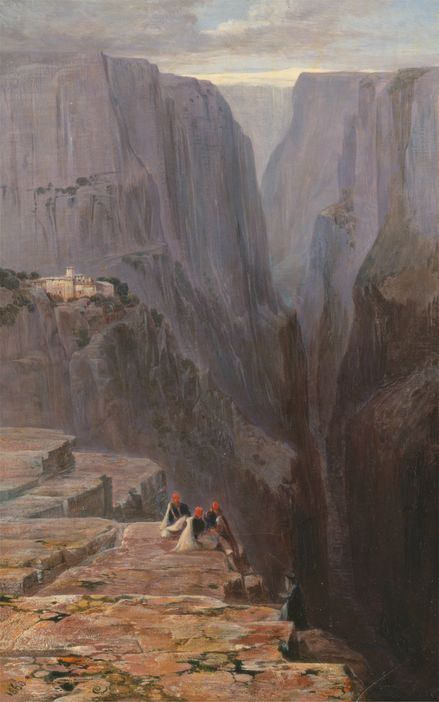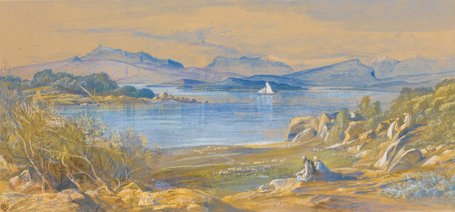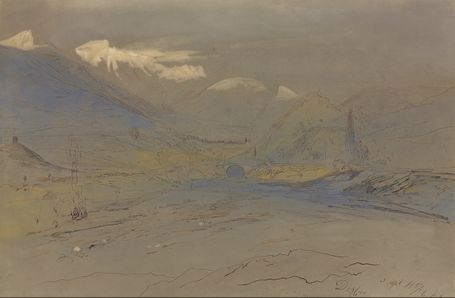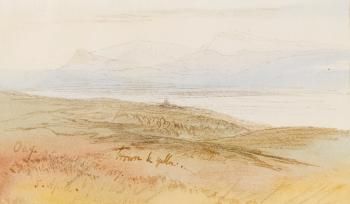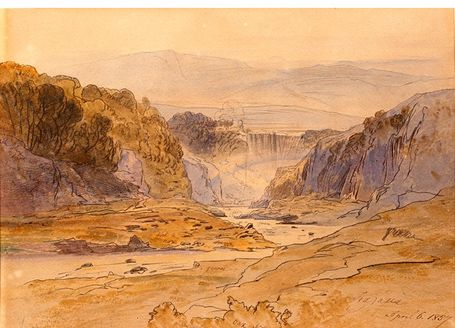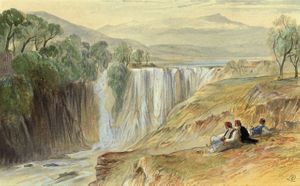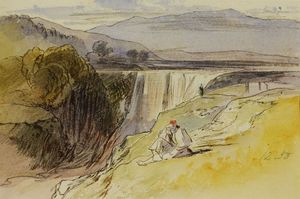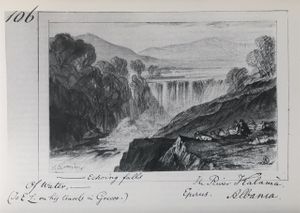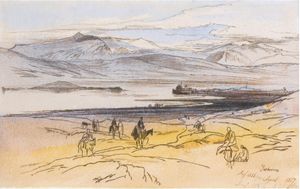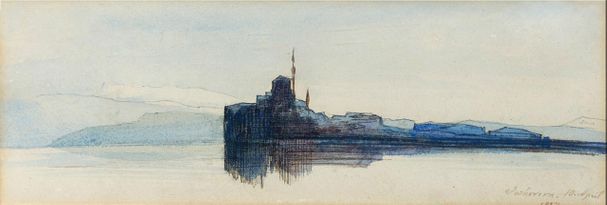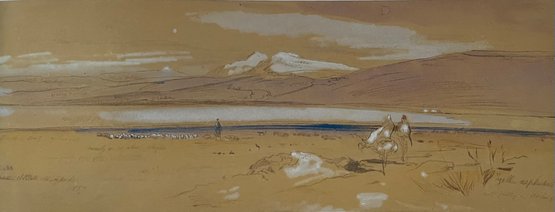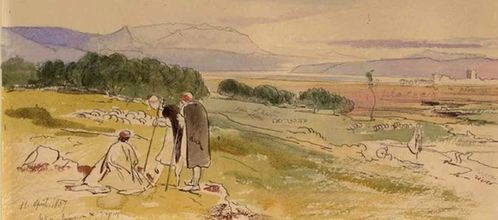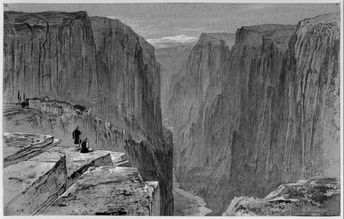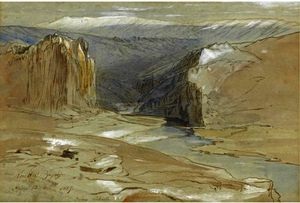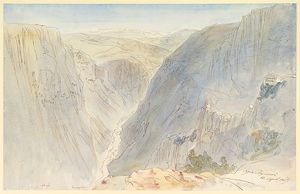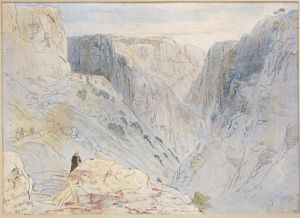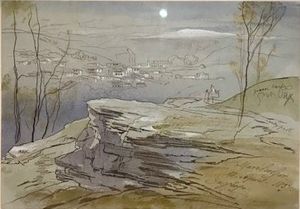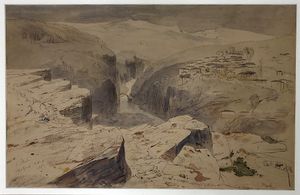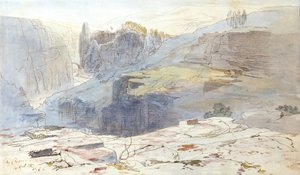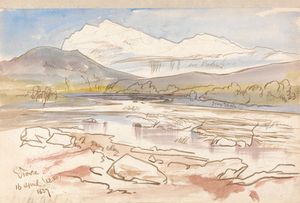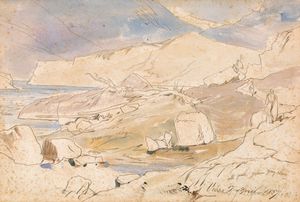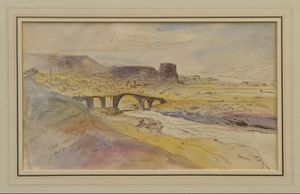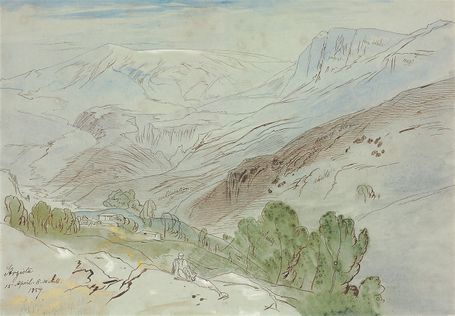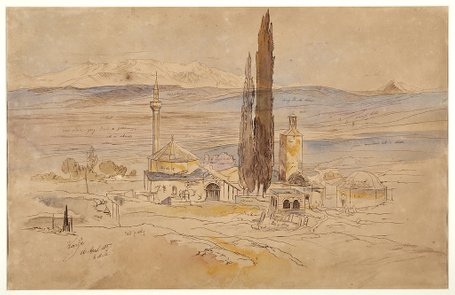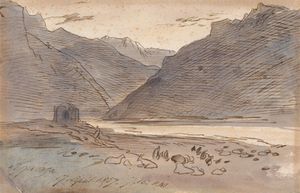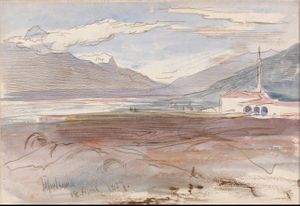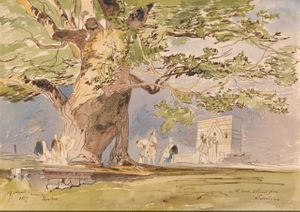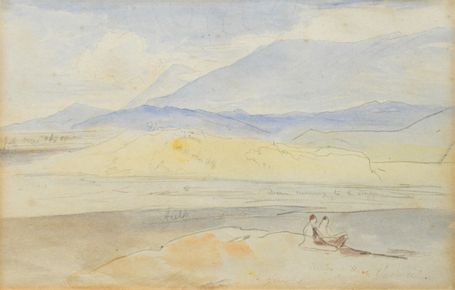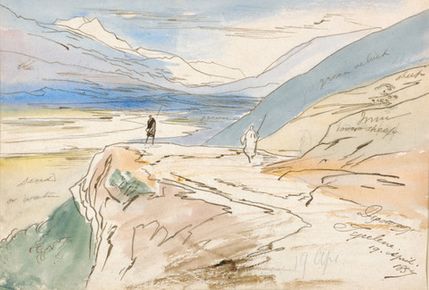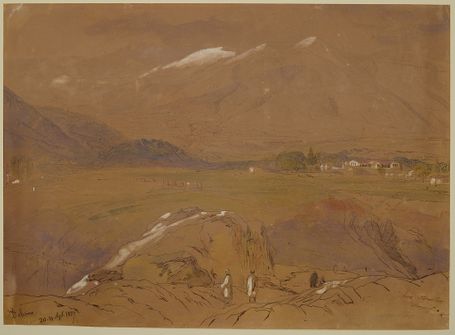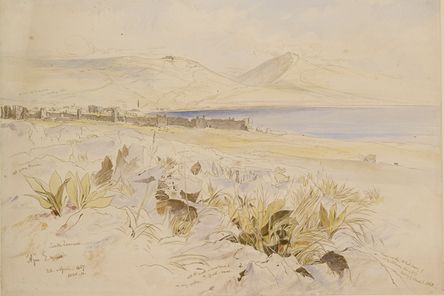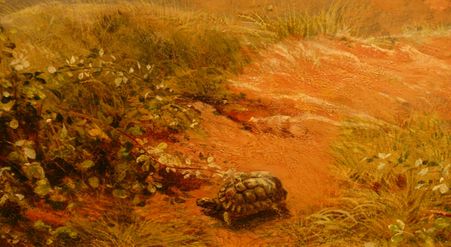Lear in Greece and Albania 1857
“Never was there such a three weeks’ lucky tour!”
As part of his project one day to visit and sketch all the Greek lands Lear made a short trip from Corfu to the mainland in April 1857.
He had already visited some of the places before, in 1848, 1849 and 1856, and had published an account, with lithographic plates, in his Journals of a Landscape Painter in Albania, &c. (London: Richard Bentley, 1851).
His new journey had two objectives: to see places, such as Zagoria, not included on the earlier trip, and to re-visit scenes marred by bad weather (“I could not hold a pencil for cold when at Janina”).
Lear’s diary for 1857 is no longer extant, and he never finished writing up the April journey for publication. A written account, transcribed below, survives only in a letter to his sister Ann (my Editor’s Note gives further details). Of the 102 drawings he made, about a third have so far been located. The album below reproduces some of these drawings, while links in the text indicate others.
Text and drawings together provide a fascinating picture of an unfamiliar area of the Balkans, recording scenes and ways of life which have now disappeared. It is still possible, however, to trace Lear’s footsteps and recognise the shapes and colours of the landscape and details of buildings, watercourses, costumes, animals and foliage.
Zagori: Monastery of Agia Paraskevi.
Oil on Canvas, 1860.
Yale Center for British Art, Gift of Donald C. Gallup.
Click on any image to enlarge
Tre Scoglie, 1862, based on 2 or 3 April 1857.
Photo courtesy of Sotheby’s.
Lear retained happy memories of this small harbour, where the yacht Midge anchored and where he enjoyed sketching on 2 and 3 April. The whereabouts of the original drawings are unknown, but a studio watercolour (illustrated) and a slightly different oil version survive.
Delvino, 3 April 1857, 6pm.
© 2018 Christie’s Images Limited.
Arriving at Delvino just in time to catch the last of the light, Lear sketched the bridge and river, with the town and mountains above. His colour notes record “russet gray” hills, “red rox” and “pale sand cliffs”.
Valley of the Kalama, 5 April 1857.
Photo courtesy of Sotheby’s.
This rapid sketch is one of several Lear made along the Kalamas River. Here he uses brown ink; his colour notes record “brown and yellow”, as he hurries to catch the fading early-evening light.
Falls of the Kalama, 6 April 1857.
Photo courtesy of Mallams, Oxford.
Lear had visited the waterfall nine years earlier (in November 1848) and admired the view in spite of “incessant drizzle of sleet, with bitter wind”. Now he enjoyed splendid views and found the cascade “as beautiful as that of Tivoli”. The rainbow spanning the gorge is very unusual in Lear's work.
Falls of the Kalama, n.d., based on 6 April 1857.
Photo courtesy of Christie’s.
Working in pencil and watercolour heightened with bodycolour, Lear made several later versions of the Kalama Falls. This one, with Lear’s monogram in the bottom right corner, originally belonged to his travelling companion in 1857, James Edwards.
Falls of the Kalama, 1858, based on 6 April 1857.
The Warden and Scholars of Winchester College.
Another, less finished, studio watercolour of the Falls. The different angle of the view suggests it was not based on the drawing in the previous column but on a similar one as yet untraced. The falls no longer exist, having collapsed in 1895 after a violent rainstorm; today a bridge spans the river.
The River Kalama, 1870s, pencil, ink and grey wash, based on
6 April 1857.
Photo courtesy of University of Bristol Library.
Lear’s long-cherished ambition to publish a book of illustrations to Tennyson was never realised. One complete set of 200 drawings, one dispersed set and many individual experiments survive. The Kalama Falls were chosen to accompany the opening lines of Tennyson’s poem
“To E.L. on his Travels in Greece”:
“Illyrian woodlands, echoing falls/ Of water, sheets of summer glass”.
Ioannina, August 1856
and April 1857.
Photo courtesy of Sotheby’s.
On earlier visits to Ioannina (1848 and 1849) Lear made several detailed drawings, with buildings and costumed figures, inside the town. In 1856, in his haste to reach Mount Athos, he hardly paused to draw. From his 1857 visit he listed 22 drawings, concentrating on more distant views of the citadel, mosques and island from the lake, with the snowy Pindus mountains beyond. Here the figures in the foreground add interest and scale.
Ioannina, 10 April 1857.
Photo courtesy of Sotheby’s.
In this beautiful pencil, pen and watercolour sketch, with its striking horizontal format (10.5 x 31.7 cm), the Fethiye Mosque is reflected in the smooth surface of Lake Pamvotis. On the furthest mountain to the left Lear notes “sno” (“I can do nothing with that magnificent lake without having seen the mountains with snow”).
Lake Lapsista, 11 April 1857.
Gennadius Library [image slightly cropped].
Beyond Ioannina, Lear skirted Lake Lapsista (now drained); this smaller lake was sometimes called Μίκρα Λαψίστα [little Lapsista], to distinguish it from Lake Pamvotis. In November 1848 the lake had been obscured by rain. Now (bottom left) he records “yellow asphodels not fully in bloom yet”.
Between Ioannina and Zagori, 11 April 1857. Laing Art Gallery, Newcastle.
Leaving Ioannina (here the town and lake are still visible in the distance) Lear set off for the Vikos Gorge and the Zagori villages. His route took him along the river plain below Mt Mitsikeli, the site of the present-day airport.
Zagori, 11 April 1857.
Photo courtesy of the Huntington Art Collections,
San Marino, California.
The Vikos Gorge, looking north towards the village of Monodrendi and the Monastery of Agia Paraskevi “placed most surprisingly amid precipices of tremendous magnitude . . . the whole thing looked more like a dream than a reality”. The scene was later worked up into an oil painting (illustrated at the top of this page).
Koukouli, Zagori, 12 April 1857.
Private Collection.
A distant view of the village of Koukouli where Lear was, for once, “well housed”. He described the surrounding landscape as “more Swiss perhaps than any I have seen”. The next day he crossed the river at the southern end of the Vikos Gorge.
Agia Paraskevi, 13 April 1857.
Metropolitan Museum of Art, New York.
The Vikos Gorge near Monodendri, looking back southwards, with the monastery of Agia Paraskevi on the right. Lear's notes on the bottom left-hand side of this drawing record “nightingales” and a “dim roar below” in the depth of the gorge. His colour notes include “sandy”, “still green” and “very okre grey”; the distant mountains are “faint blue”, “deeper blue” and “lilac”.
Agia Paraskevi,
13 April 1857, 11.30 am.
Cincinnati Art Galleries LLC.
The view from a little further north, with the monastery just out of sight beyond an outcrop. Lear captures the changing light on the complex rock formations and adds distant figures on a path and a woman in local costume in the foreground.
Monodendron, 13 April 1857.
Derek Johns Family Trust.
Lear’s landscapes are always accurate in their geological detail; in this drawing he focuses on one of the striking limestone formations characteristic of the Vikos Gorge. Moonlit scenes are unusual but not unknown in Lear’s landscapes.
Baïa, 14 April 1857, 8 am. [sketched on 12 April]
Gennadius Library, Athens.
Valley of Zagóri [Baïa],
14 April 1857, 10 am.
[sketched on 12 April]
Private collection.
Three of Lear’s views of the village of Baïa (present-day Kipoi) survive. From slightly different vantage points, he looks north up the Voidomatis River, composing the scene around one visible arch of the (two-arched) Lazaridi bridge, which dates from 1753.
For the third drawing, made in the afternoon of 12 April, click here.
Viosje, 16 April 1857, 12.30pm.
Yale Center for British Art, Gift of Donald C. Gallup.
For three days Lear followed the Vjosë / Aóös River from Konitsa to Tepelene, a distance of 100 km. In this drawing Mt Nemertska forms the background to a study of the meandering river.
Viosje, 17 April 1857.
Yale Center for British Art, Gift of Donald C. Gallup.
At a point between the present-day Greek-Albanian border and the town of Përmet, Lear paused to make a rapid sketch (with figures to indicate scale) of the path beside the river.
Premeti, 17 April 1857.
Photo courtesy of Reeman Dansie, Colchester.
Passing through the town of Premeti/Permeti (Përmet), Lear drew the famous “stone” and the arched bridge over the Viosje (now demolished).
Arzista, 15 April 1857, 8.30 am.
© 2018 Christie’s Images.
Arzista (present-day Arísti) is situated below the villages of Mikró and Megálo Pápingo. At 8.30 am, when Lear paused here to draw, he had already covered a quarter of his day’s walk from Pediná to Kónitsa. He notes “walnuts”, “large oax” and “ilex” against a background of”cloud”, “sno”, an “immense hollow” and “perpendicular” rocks.
Konitsa, 16 April 1857, 6 am.
Gennadius Library, Athens.
From above a mosque complex (now ruined) Lear depicts the plain of Kónitsa in the middle distance, and the mountain range beyond. The early-morning colours are muted, with much of the landscape still in shade. This is the north-eastern limit of Lear's journey.
Kleisura, 17 April 1857, 7.15pm.
Yale Center for British Art, Gift of Donald C. Gallup.
Lear spent the night of 17 April at a “horrid khan” at Kleisura (Këlcyrë); this drawing depicts a bend of the Vjosë river, with a ruined building and goats, in the last of the evening sun.
Tepelene, 18 April 1857.
Yale Center for British Art, Gift of Donald C. Gallup.
Tepelene, with its Byronic associations, was on Lear’s earlier route in 1848 when he made detailed drawings of the town with its “silver-toned” mosque: “one of the most sublime and simple scenes in Albania”. In this later sketch he revisits the landscape in outline: mountains, river, promontory and mosque.
On the road, two hours from Tepelene, 19 April 1857.
Yale Center for British Art, Gift of Donald C. Gallup.
Two hours into the day’s seven-hour walk Lear stopped at a beautiful fountain built by Ali Pasha beneath a stand of plane trees. The foliage in the foreground is drawn with flair, and the placing of the figures makes for a satisfying composition.
Ruins of Khan Valaré, 19 April 1857.
Photo courtesy of Cheffins Auctioneers, Cambridge.
After about five hours’ walking from Tepelene Lear passed the site of the former khan of Valaré (Valarë). He briefly sketched the swift stream of the Sukha, which descends obliquely from Mt Nemertska before, he notes on the drawing, “running into the Dhryno”.
Deropouli, Tepelene, 19 April 1857.
Yale Center for British Art, Gift of Donald C. Gallup.
Later on 19 April the landscape opened out into the plain of Deroupoli/Deropoli (Dropull). In 1848 Lear had found it “pictorially speaking, rather straight and monotonous”; here the curving road and the distant view of mountains provide visual interest.
Delvino, 20-21 April 1857.
Gennadius Library Athens.
Returning via Delvino, Lear took the opportunity of sketching on the plain below the town. (He also completed the handsome drawing of the Turkish fort begun in August 1856.)
Santa Quaranta/ Agii Saranda, 22 April 1857, 11 am.
Ashmolean Museum.
While waiting for a passage back to Corfu Lear sketched the town and bay and in the distance his “own particular mountain”, which he could see from his rooms in Corfu. He later noted (bottom right): “Penned out this, the last drawing of all the Albanian tour in 1857, evening of March 6, 1862”.
Lear’s account of his 1857 journey
Ioannina, oil on canvas, 1864 (detail); based on a drawing of 1857. Private collection.
Corfû, April 23rd, 1857
My Dear Ann,
Here I am safe & sound—back again. We returned this morning or last night at 2 after midnight—& never was there such a 3 weeks lucky tour!—only with the exception of Giorgio's [note 1] having the fever for 3 days. Weather lovely always—except one storm, which we sat out in a cave. And I bring back—large & small—98 sketches [in fact 102], so that my illustrations of Epirus go on pretty well. I wrote to you on the 30th March, & find an answer to that letter which is very welcome.—as well as a reply—date March 31st—to mine of the 15th. —Both of these I will answer presently, when I have told you somewhat of myself. First, however, for fear I should forget—let me thank you for the chocolate—which was valuable & delightful beyond expectation. It lasted us exactly—the very last bit being divided yesterday. I found it more useful as luncheon; a piece of bread, a bit of Bottarga, chocolate—& 2 oranges—were our daily midday meal—half a stick & 6 drops being the allowance of each. My companion, Edwards [note 2], Mr Parker’s Godson, was a most admirable one—; kept all the accounts, walked every bit of the way, hit all the dogs on their noddles, & drew nearly as much as myself. Moreover, he will draw admirably well—& there is much pleasure in teaching him.
Ioannina, oil on canvas, 1864 (detail); based on a drawing of 1857. Private collection.
Since our return, he has just sent me a nice kind note from Mr Parker (his Godfather) now living at Manchester & I am so glad that my poor old friend is so much pleased at knowing of my meeting with his friend's son. Well; we were off on the 2nd April in Lushington's [note 3] boat the Midge,—I taking Giorgio, the canteen or box of cooking things, my bed—paper for drawing etc.; & Edwards taking his servant Filippo (a Maltese). We had a perfectly quiet passage across of only 3 hours & anchored in the little harbour of Tre Scoglie [Ksamil],—enjoying all the afternoon in making drawings-—below the tall white heath all in bloom—& having a comfortable dinner & quiet night.
Early on the 3rd we found some woodcutters’ horses by the shore, & as there was no wind to take us on to Santa Quaranta [Sarandë], the proper place for landing to go to Délvino [Delvinë],—we hired them, & set off walking, all along the lake of Butrinto—which I did not draw, because it is within a 2 hours’ sail any day. We got to Délvino in time to make a drawing of that place, I think altogether the very prettiest I know in all Albania—so green—& countryfied—such pretty houses scattered about with rox & trees, & running streams, & the great mountains above all. We were housed in Abdul Bey's house; he was away, but his son came & ate supper with us—& very nasty it was;—all the better for preventing too much eating. This time I bought a new bed—like Edward's—& you have no idea of the comfort I have had from it; instead of a mattress on the floor, this stands on 6 portable legs—& being covered with a scarlet blanket is beauteous to behold, as well as inaccessible to vermin. Giorgio & Filippo made the nastiest of Khans assume some sort of comfortable air by these 2 well arranged beds, a blazing fire, & a table with legs which Edwards took.
On the 4th we set off—always very early—5.30 or 6—to try to get to Delvináki, but we found it was too long a journey—over those difficult mountains —past the plain of Δερόπολη [Derópoli/Dropull]; so we could not get further than the nasty Khan at Ξηρόβαλτο [Xiróvalto], where we adapted ourselves as best we might. Next day, 5th, we left the baggage to go & see the town of Δελβινάκι [Delvináki] & rejoined it before it reached Ζerovína [Zaravína], where the Khan I slept at in 1848 [note 4] was all tumbled down, so we went to another at Moorsià [Sitariá]—a very nasty place & although we seized on a stable & adorned it with fire, scarlet beds, & table, there were 60 or 80 Albanians in the next partition who were noisy all night, besides that an old hen would walk about me every half hour, & her husband came & crowed straight into my right ear, at which Edwards laughed, but I was ready to cry. I am happy to say that I gave that wretched old couple such a poke at last that they will neither crow nor cackle on Christians’ beds for a long time without feelings of remorse.
Next day—6th—the views were splendid over the wonderful valley & mountains of Zagori, the district I particularly intended seeing. The crags of Mt Lazarin [Týmphi] were perfectly astonishing, & promised great interest. All down the valley of the Kalama [Kalamás] (where I had bad weather in 1848) we were delighted, & the cascade [note 5] of the river is as beautiful as that of Tivoli. We slept at Zitza—the monastery. 7th: The view from Zitza is disappointing—so I have not changed my opinion [note 6]; also the route to Jannina is tiresome—just as ever; but the extreme beauty of the city & lake, now that the mountains are covered with snow, astonished me. We were tolerably lodged—& I worked hard through the 8th 9th & 10th—getting some valuable & correct views of the place, which I had never before been able to do. You have no idea what hundreds of tortoises were walking about everywhere! I took one little mite of a brute—not bigger than half a crown—& put him in my pocket to bring to England for poor little Allan Nevill; he is toddling about the table now [note 7].
On the 11th we set off to Dobrà [Asprángeli]—the first village in Zagori, which is a district of Christians, who, never having rebelled against the Turks, have enjoyed great privileges, & are the most civilized of all the Albanian inhabitants. They are true Greeks, & Epirotes, & no Albanian is spoken. Moreover they live in such queer places that I don't see how any Turks could ever have got at them if they had wished. Stone being cheap—they make wonderful houses—such as you see in London or Paris—with Venetian blinds, porticos etc. etc.; but as nothing grows in Zagori, the owners all go abroad & are rich merchants at Smyrna, & Constantinople, etc. etc., returning every 7 or 10 years to their houses. So you walk through these fine places stuck in unapproachable situations, & see nobody but children & women—& a few old men. 12th: we got to Koukoúli—one of the largest villages, & were nicely housed. It is impossible to give any idea—except by my drawing, of the surrounding scenes—more Swiss perhaps than any I have seen. On the 13th we went to Manassís, & Mοnodéndron, 2 large towns near a monastery [Agía Paraskeví] placed most surprisingly amid precipices of tremendous magnitude,—on a great gorge of Pápingo. The rocks rise clear—perpendicularly—more than 1,500 feet from the river, & the whole thing looked more like a dream than a reality. On the 14th we saw a good deal more of Zagori, & slept at Sudenà [Pediná]—& here Giorgio fell ill of fever, which he had got, I think, carelessly at Jannina.
Next day, 15th, however he was better, & Edwards & I walked on alone to Kónitza, a large town—the furthest of our tour. All this is just like Switzerland—pines—& bears—& chamois—& what not. The 16th took us all along [note 8] the great River Viosa [Vjosë/Aóös] to Tzetzota [unidentified]—Giorgio being in his fever fit again; fortunately Filippo was as good natured as capable & did double work. The walk of the 17th by the side of the Viosa was magnificent, & we went on by Περμέτι [Përmet], as far as Κλεισούρα [Këlcyrë], where we slept in a horrid Khan. Thence, to Tepelene [Tepelenë]. 18th the scenery is most romantic & magnificent, but Giorgio was very ill; happily I found some quinine, & this was his last attack. We crossed the river in a thunderstorm, the only rain we had, & got to Tepelene, where I was the 2nd time in my life wandering about Ali Pasha's Palace ruins. 19th a quiet walk to Argyrókastro [Gjirokastër]—& on the 20th—a very good one over the mountains to Delvino once more—all brilliant in fresh green—with lilac flowered Judas trees everywhere, & nightingales singing on all sides, was most exquisite. We heard here that Sir John & Lady Young, Miss Lambert, Lane, Mr Curzon & Col. Talbot, had passed on the 16th on their way to Jannina,—but not Sir P. & Lady Hunter as we had expected [note 9].
21st—We left Delvino for the shore, bemoaning ourselves that the only really hard part of our trip was at hand—namely a passage in a country boat—dirty & slow,—for Lushington we knew had gone on his Easter trip down to Ithaca, & we had no friends to fetch us away. But half way to Santa Quaranta—(the Scala, or port of Delvino) there we met Sir Paul & Lady H. & Miss McKenzie, Lady H's. father—(old Mr. Bosanquet of Rome) having died, so that they had given up joining the large party, & were to return the following day. Meanwhile, Edwards & I had leave to take possession of the Royal yacht—(not to speak of some lovely boiled beef (cold) (& bottled ale!) so there we housed ourselves quietly—sending back our muleteers—who, as if all was to be fortunate in this trip, were a faultless lot—& making ourselves comfortable till yesterday afternoon, when Sir P. & Lady H. having returned from Delvino, we all set sail, & creepy, creepy, creepy, tack, tack, tack, got here this morning as I said. I am rather sleepy [. . .]
[1] Lear’s servant, Giorgio (George) Kokáli.
[2] The 22-year-old James Bevan Edwards (later Lt. Gen. Sir James Edwards) was an army officer who had already fought in the Crimean War. He was the son of one of Lear’s patrons and collectors, Samuel Price Edwards.
[3] Franklin Lushington, a lawyer and classical scholar, had toured Greece with Lear in 1849. He was serving as a judge in Corfu.
[4] Even in 1848 it had been wretched: “a solitary, walled, dilapidated building, not promising in appearance” (Journals of Landscape Painter pp. 323-4).
[5] The famous waterfall collapsed in 1895.
[6] It had failed to live up to its Byronic fame in 1848: "the view from Zítza, to speak plainly, disappointed me" (Journals of a Landscape Painter, pp. 325-8; 328.) Or, more plainly, in a letter: “Zítza is an umbug”.
[7] Lear always liked tortoises and was knowledgeable about chelonians since his work illustrating Thomas Bell’s Monograph of the Testudinata (1832–6). His large oil painting of Ioannina (private collection) features in the foreground a meticulously-depicted tortoise. Lear told Ann “I have with me 2 very tiny tortoises, in an Albanian wooden red box . . . Just now I have let them out for exercise,—& mine has gone off at a gallop to poke himself into a dark corner; he is not 2 inches long—& came all the way from Jannina”. Allan Nevill, whose mother had just died, was one of Lear’s godsons.
[8] In 1848 Lear had walked 100 km along the lower reaches of the Viosa from Avlona (Vlorë) to Tepelene; adding the 1857 route meant that he had followed almost its entire length.
[9] Lear’s various Corfu acquaintances include Sir John Young (Lord High Commissioner of the Ionian Islands) and Col. Talbot (British Resident at Cephalonia).
Editor’s Note
The originals of almost all Lear’s letters to his sister Ann are now lost. Typed transcriptions were made in the 1930s, and my text is based on one of these copies, by kind permission of the present owner, Dr David Michell. The transcriptions were reputedly made with some care and include handwritten corrections and insertions (for instance of Lear’s Greek script) and ink copying of the maps and sketches. They nevertheless introduce errors in spelling and, in particular, in proper names. In transcribing what is already a transcription I have tried to be as faithful as possible to Lear’s style as we know it from his autograph letters.
Lear’s punctuation is fairly informal, with copious use of dashes, which I have retained. Ellipsis points indicate where I have omitted material not relevant to the particular journey, and square brackets indicate an editorial interpolation. I have introduced paragraph spacing for ease of reading.
Greek place names are a problem in English but I have aimed to be as clear and consistent as possible. Lear uses accepted English forms (e.g. Corfu, Salonica) where they exist; otherwise he generally follows Leake’s spelling (see W.M. Leake, Travels in Northern Greece, 4 vols., 1835). Many places had two or more different names (Turkish, Albanian, Slav, Greek) until hellenisation became widespread in Greece from the 1920s onwards. I have supplied present-day names where necessary, with stress accents to indicate pronunciation.
I should like to thank Stephen Duckworth and Charles Lewsen for their help in the preparation of this webpage.
